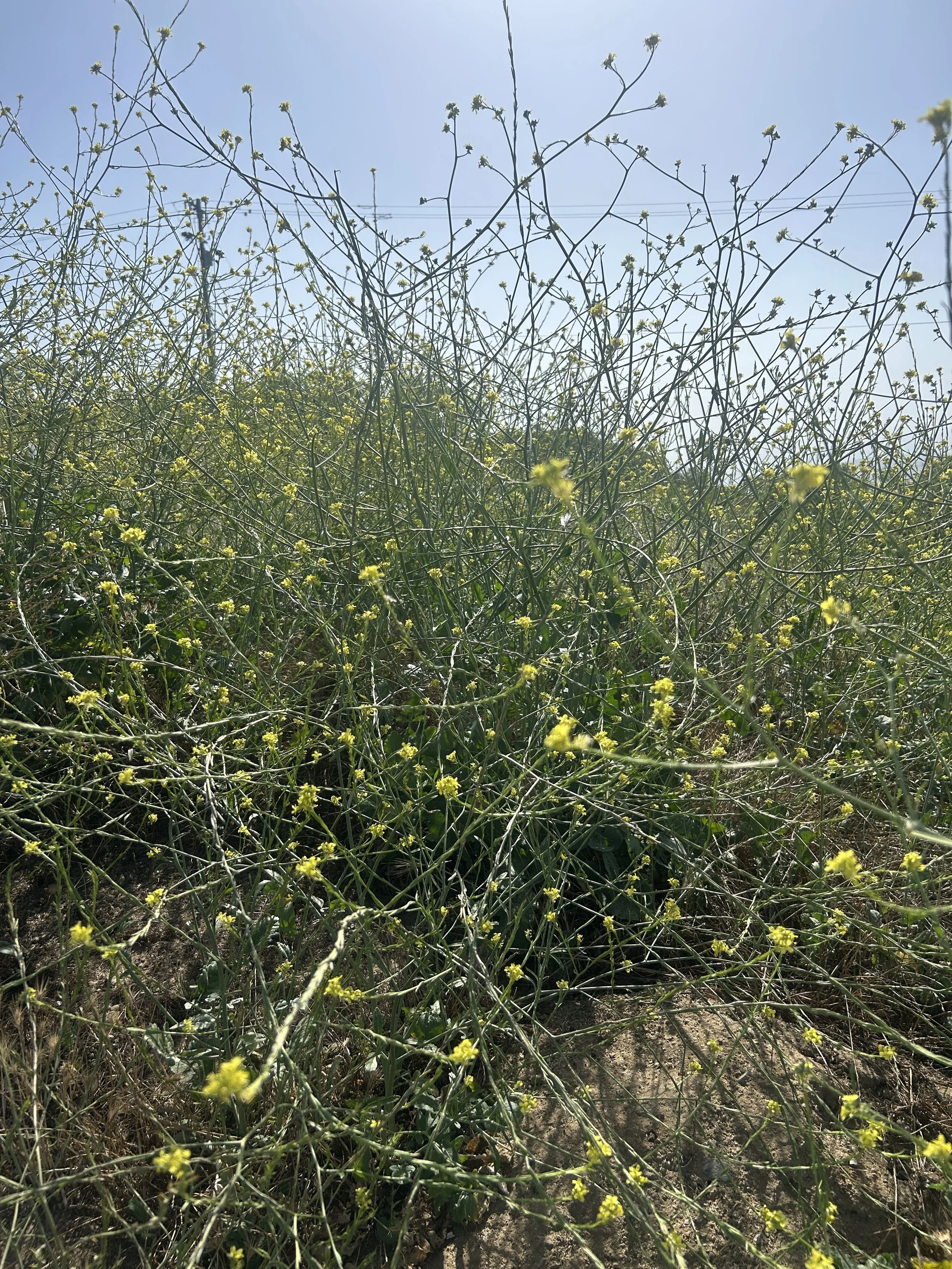Black Mustard: A Reminder of California’s Colonial History
There are 3 things that early summertime in Southern California guarantees each year- the skies will be overcast (May Gray/June Gloom as we call it), everyone in the area will suffer a kind of collective amnesia over the fact that it is always cloudy at this time, and every open space will be blanketed in tall, weedy plants tipped with tiny yellow flowers. This plant is called black mustard (Brassica nigra), and it’s an herb that grows all over the United States but is especially pervasive in California. Black mustard often pops up in spots like meadows, roadsides, and hiking trails, all disturbed areas where many other plants struggle to grow. It looks beautiful, and over time it has transformed shrubby and desolate seeming hills into bright, golden fields. But within the black mustard’s unsuspecting appearance hides a reminder of an insidious history of violence, destruction, and California colonialism.
Black mustard, though widespread, is not native to the Americas. Its detection in adobe bricks of missions indicates that it was brought to this region by Spanish settlers in the late 1700s, which was the time of the first introduction of invasive species to modern-day California. There’s no verifiable reason “why” the plant was introduced, but one story we often hear is that it was spread by Spanish missionaries as they moved throughout the region so that they would know where they had been and be able to retrace their steps. The mustard would mark El Camino Real, which is the network of roads that historically connected California missions. Some people also suggest that the bright yellow color was meant to guide people to the missions, creating smatterings of colorful flowers that stood out against the landscape. Whatever the reason, European settlement, land “development”, and increased cattle grazing contributed to its spread, and over the last 300 years it has become prevalent across the United States.
Brassica nigra is not only a nonnative species, but it is also invasive, meaning it poses a threat to the habitat in which it exists and is extremely difficult to control. It spreads fast because it outcompetes indigenous plants by germinating earlier in the year than native species, allowing it to establish a foothold in the soil before others. This disrupts the entire ecosystem because it prevents growth of native vegetation, which reduces food and habitat resources for wildlife who are reliant on them. Because black mustard has dense roots that prevent growth of other species, it also changes the soil composition which is determined by the plants that decompose and contribute certain nutrients that are essential to sustaining future flora. Additionally, it releases allelopathic toxins that dissolve into water and disrupt germination of nearby grasses. Many of the regions where the mustard grows are also prone to wildfires, which are becoming an increasingly frequent issue as they are accelerated by climate change. Mustard increases fire risk in these areas because it becomes very dry in the summer and is easily combustible, and its height creates an effect called “laddering” where fires are able to travel from shrubs to trees. And because it grows faster than other species and outcompetes them on several fronts, black mustard establishes itself first after a fire, thus exacerbating all of the issues it causes. Brassica nigra grows all over the place, and with no effective management strategy these damaging feedback loops that are occurring across the country will only worsen, with no real end in sight. In many ways, the plant’s story is an allegory for the impacts of European settlers in America.
The modern day state of California has a long history of colonialism that is often swept under the rug. The 18th century Spanish mission system, remnants of which are still memorialized across the region, was created in an attempt to evangelize local indigenous people. Missionaries engaged in and promoted a variety of different colonial acts, including displacing and starving natives, enslaving them on mission compounds, removing their children from their families and selling them into slavery. Franciscan friars raped, tortured, and massacred thousands of indigenous people, while also exposing them to deadly diseases for which they had no developed resistance against or experience treating. The violence continued on through the 1800s, as both the state and federal governments paid settlers to murder natives in the decades during and following the Gold Rush. This enabled and encouraged attempt at eradicating indigenous tribes is known as the California genocide, and it decreased the native population from an estimated 150,000 to 31,000 people. Despite this abhorrent history, missions remain today, and children are still taught a romanticized and incomplete account of the mission system. The same mission system that brought destructive black mustard to North America.
When we look at the mustard within the context of California’s history, it becomes evident that it is not just a flower, or even just an invasive plant, but rather a modern continuation of the colonial campaign that has deprived this land of its original caretakers. Brassica nigra itself continues to harm indigenous ways of life. The plant makes it difficult for indigenous people to grow their historically significant crops, thus impeding native self-reliance and forcing engagement with an environmentally damaging (and Western-based) food production system. This herb crowds out native plants and makes their presence untenable in the same ways that missionaries did to native people. Black mustard is a reminder of our history, a reminder that even long after the initial acts of violence, the impacts of colonialism persist. It is also a reminder to all of us here from different parts of the world that the land we live on is not ours.
